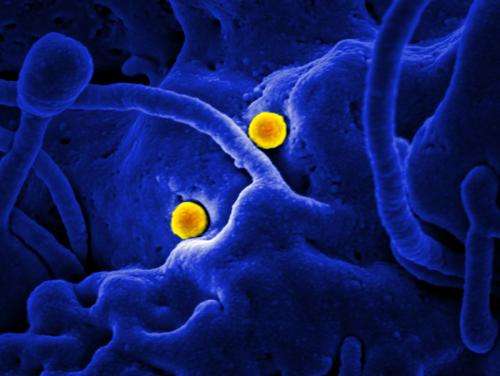The marmoset animal model recapitulates disease symptoms of MERS infection in humans

An article published on August 21st in PLOS Pathogens reports the first animal model that recapitulates the severe and sometimes lethal respiratory symptoms seen in human patients and suggests that the common marmoset will play an important role in the development effective countermeasures against Middle East respiratory syndrome corona virus.
Recent studies had identified how the MERS-CoV recognizes and invades human cells: its spike protein binds to DPP4, a protein on the surface of human cells, and this leads to internalization of the virus which then takes over the human cell and turns it into a virus factory. Variations in DPP4 between animal species seem to determine susceptibility to MERS-CoV infection. For example, mice, hamsters, or ferrets, whose DPP4 is quite different from the human protein, seem resistant to the virus while rhesus macaques, whose DPP4 is very similar to the human one, are susceptible. However, while they can be infected with MERS-CoV, they develop only mild-to-moderate symptoms, unlike many human patients that carry very high loads of virus, get seriously ill, and sometimes die.
Rather than randomly testing animal species that might provide a better model by infecting them with MERS-CoV, researchers led by Heinz Feldmann and Vincent Munster (both from Rocky Mountain Laboratories, part of the U.S. National Institute of Allergy and Infectious Diseases in Hamilton, Mont., USA) set out to identify animals whose DPP4 protein was similar to humans, especially the part known to bind directly to the viral spike protein. They found that marmoset DPP4 has an identical amino-acid sequence (amino acids are building blocks of proteins) to human DPP4 in the critical region. A three-dimensional model confirmed that any DPP4 amino acids that differed between the marmoset and human proteins are located away from the part of DPP4 that binds the viral spike protein.
Having thus good reasons to believe that marmosets would be susceptible to MERS-CoV infection, the researchers went on to infect nine animals with the virus. All of them got sick, and their lungs contained high loads of virus and showed signs of immune response and inflammation. Most animals developed progressive severe pneumonia, and two animals had to be euthanized according to pre-determined guidelines, because their condition worsened dramatically.
While this is an initial report and the researchers point to the need for additional experiments, they see several advantages of the marmoset over the rhesus macaque model and expect that "marmosets will serve as the animal of choice for future therapeutic studies where possible." They also state that "the development of the more severe marmoset model will ensure a better pre-clinical analysis of treatments prior to clinical trials in humans" and express the hope that their model will make "a significant contribution to reducing the impact of MERS-CoV on global public health."
More information: Falzarano D, de Wit E, Feldmann F, Rasmussen AL, Okumura A, et al. (2014) Infection with MERS-CoV Causes Lethal Pneumonia in the Common Marmoset. PLoS Pathog 10(8): e1004250. DOI: 10.1371/journal.ppat.1004250
N van Doremalen et al. Host species restriction of Middle East respiratory syndrome coronavirus through its receptor dipeptidyl peptidase 4. Journal of Virology DOI: 10.1128/JVI.00676-14 (2014).















